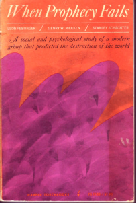

This material is part of the Field Guide profile of the End Times Prophecy Movement.
Click here to go to the Introductory Overview of that movement.
When Prophecy Fails
From the time that Jesus Christ returned to heaven after His resurrection, there have been people yearning so badly for his return to earth that they have poured over the prophecies of the Bible to try to "discern the times" in which they lived. Every generation of Christians has hoped they were living in the time when the clouds would be rolled back as a scroll and the Lord would descend to put an end to Man's miserable rule over Man.
And in many of those generations, Bible students have been convinced that they have been able to determine, through the prophetic hints in the Bible, that Jesus was, indeed, coming soon, in the lifetime of most living in their own generation. Not content with just the general hope, many have also worked out elaborate mathematical schemes whereby they could pinpoint not just the generation, but the decade, the year, the month, perhaps even the day that their "blessed hope" would be fulfilled.
This phenomenon has increased greatly in the past two centuries, and even more in the past two decades. Teacher after teacher, group after group has arisen to publish magazines, books, pamphlets, study guides and more to convince others of the certainty of their predictions of chronological details of "the Return." Thousands of lectures and sermons have been given and thousands of TV and radio programs have been recorded all with the primary aim of persuading the public to get on the bandwagon of the latest prediction of the year of the start of the Great Tribulation, or the "rapture," or even the Advent of the Lord Himself.
The pace of this speculation grew even more frantic in some religious circles as the year 2000 approached. Even those who didn't normally focus on dates seemed to be mesmerized by the number of zeros after the 2! Surely, thought many, the Lord will tarry no longer than the end of the millenium. Thus dogmatic pronouncements on specific dates were plastered on websites, trumpeted on radio talk shows, circulated in newsletters. Many ministries have arisen with the primary goal of bringing together in fellowship under one teacher or group those who were convinced of the prophetic scenario of that teacher or group. Each of these may have also taught elements of the Gospel and truths from the scriptures, but in many settings these almost seemed to be an afterthought. The biggest publicity, the most printed material, the most "bandwidth" on radio and on the Internet was devoted to endless feeding of the desires of followers for more and more details about the prophetic scenario.
To date, ALL of these many, many, many prophetic pronouncements of the past 2000 years have failed.
"When prophecy fails," what happens to all those faithful supporters whose generous tithes and offerings made the programs and publications and personal appearances to promote the prophecies possible? Common sense would suggest that they would abandon the ministries which had misled them. Common sense would indicate they would accept the reality of the failure and get on with their life, adjusting their priorities to give more attention to Bible basics and daily Christian living.
Common sense would be incorrect.

Examination
There is a famous book from the 1950s that is a classic in Social Psychology courses
called When Prophecy Fails. The researchers preparing the book stumbled on a "flying
saucer cult," which was predicting "the End," just then forming. In studying apocalyptic
groups of the past which set dates for the Return of Christ or the End of the World,
the researchers had come to some theories about what happens to members of such groups
"when prophecy fails." They outline those in the beginning of the book, and then
embark on a case study of the new cult to see if their theories applied. They did,
perfectly.
Fails. The researchers preparing the book stumbled on a "flying
saucer cult," which was predicting "the End," just then forming. In studying apocalyptic
groups of the past which set dates for the Return of Christ or the End of the World,
the researchers had come to some theories about what happens to members of such groups
"when prophecy fails." They outline those in the beginning of the book, and then
embark on a case study of the new cult to see if their theories applied. They did,
perfectly.
This theory has since been applied to other modern cults, and found to be accurate. Below is an excerpt from a website which uses it to evaluate what happened in the Jehovah's Witnesses group when their date of 1975 for the beginning of the visible Kingdom on earth (and many earlier dates they set for the same event) came and passed with no fulfillment. This is introductory material which explains the basis of the theory. (Italics and bolding have been added in a few places to call attention to words or indicate a title.)
In studying this phenomena, credit must be given to Leon Festinger for his cognitive
dissonance theory, as developed in his book When Prophecy Fails, originally published
in 1956 and co-
Festinger observes:
"A man with a conviction is a hard man to change. Tell him you disagree and he turns away. Show him facts or figures and he questions your sources. Appeal to logic and he fails to see your point. "We have all experienced the futility of trying to change a strong conviction, especially if the convinced person has some investment in his belief. We are familiar with the variety of ingenious defenses with which people protect their convictions, managing to keep them unscathed through the most devastating attacks. "But man's resourcefulness goes beyond simply protecting a belief. Suppose an individual believes something with his whole heart; suppose further that he has a commitment to this belief, that he has taken irrevocable actions because of it; finally, suppose that he is presented with evidence, unequivocal and undeniable evidence, that his belief is wrong: what will happen? The individual will frequently emerge, not only unshaken, but even more convinced of the truth of his beliefs than ever before. Indeed, he may even show a new fervor about convincing and converting other people to his view. "
When Prophecy Fails focuses on the failure of prophecies to come true, termed disconfirmation
by Festinger, and the accompanied renewal of energy and faith in their source of
divine guidance. His theory presupposes the cult having certain identifying features,
such as: (a) belief held with deep conviction along with respective actions taken,
(b) the belief or prediction must be specific enough to be disconfirmed (i.e., it
didn't happen), (c) the believer is a member of a group of like-
Of particular interest in Festinger's book is how the followers of Mrs. Keech reacted to each disconfirmation (failed date). Little attempt was made to deny the failure. The strength to continue in the movement was derived, not largely from the rationalizations , but from the very energy of the group itself and its dedication to the cause. This explains why proselytizing wasso successful later in reinforcing the group's sagging belief system. Festinger relates:
"But whatever explanation is made it is still by itself not sufficient. The dissonance is too important and though they may try to hide it, even from themselves, the believers still know that the prediction was false and all their preparations were in vain. The dissonance cannot be eliminated completely by denying or rationalizing the disconfirmation. But there is a way in which the remaining dissonance can be reduced. If more and more people can be persuaded that the system of belief is correct, then clearly it must, after all, be correct. Consider the extreme case: if everyone in the whole world believed something there would be no question at all as to the validity of this belief. It is for this reason that we observe the increase in proselytizing following disconfirmation. If the proselytizing proves successful, then by gathering more adherents and effectively surrounding himself with supporters, the believer reduces dissonance to the point where he can live with it."
In the end, the members of the flying saucer cult did not give up their faith in the Guardians from outer space with their promises of a new world. Despite numerous prophecies and the resultant disappointment accentuated by many personal sacrifices, the group remained strong

Personal from the Webauthor
I first encountered Festinger's book and the theory of cognitive dissonance while taking a course in Social Psychology at Michigan State University in 1974. The book was required reading.
At the time, I had been a member of the Worldwide Church of God (WCG) for several years. Founder Herbert Armstrong had bombastically led his supporters to accept the year 1972 as the deadline for The Church to be whisked to a "Place of Safety" prior to the Great Tribulation, which would be followed by Christ's Return in 1975. When this failed, a number of followers had become disillusioned and left the organization, but a large percentage had not. At the time, it did not occur to me to apply the information I was learning in the course to my own personal circumstances! But it surely did apply.
In looking back and examining why I was not totally disillusioned by the disconfirmation
in 1972, I can only conclude it was because my husband and I had already invested
so much of our time, efforts, and financial resources in the organization. The level
of discomfort and confusion at the single event of the disconfirmation was not high
enough to off-
This off-
When I saw confusion all around me, when I saw outright lies published by the church Headquarters, when I saw mountains of evidence of corruption and greed and profligate extravagance and distortion of the facts, I was unable to just gloss it over in order to resolve the dissonance and bring my mind into a peaceful state again. I had to have answers. And even though the answers were painful, I found facing them more tolerable than staying in ignorance, and having my mind in a state of perpetual cognitive dissonance.
After our departure from the WCG—and later Garner Ted Armstrong's Church of God, International—I began my study of groups which had predicted The End or who had claimed an exclusive position as the only true expression of The Church on earth. And while studying the Jehovah's Witnesses, the Mormons, and the Seventh Day Adventists, I discovered they had all been subject to incredible inner turmoil from about 1970 on because of failed prophetic speculations and/or revelations about some of their cherished teachings and foibles of their founders and current leadership.
The same sort of internal politics that I experienced in the WCG and CGI, that forced
me out of those groups, were rampant in these other groups. And thus thousands upon
thousands of folks ... including long-
The following is an excerpt from an article on prophetic speculation which I wrote in 1989. It gives further commentary and documentation on some of the points above.
~~~~~~~~~~~~~~~~~
"A thing that strikes one who browses around in the vast literature that has grown up about the book of Revelation is the UTTER DOGMATISM with which so many put forth their opinions, not as opinions, but in categorical statements, as to the meaning of the most mysterious passages, as if they know all about it, and their say so settles the matter. We think a spirit of reverent humility, and openness of mind, would be more becoming in those seeking to interpret a book like this." Henry Halley, Halley's Bible Handbook (24th ed., P.684)
Wise counsel! Why has it been so widely ignored among modern commentators? I offer
a possible answer: with a limited audience among which to garner supporters for evangelistic
ministries, the most dogmatic teachers are often the most successful at gathering
around themselves the most enthusiastic-
Amazingly, this desire for security is so strong that many teachers are even able
to hedge their prophetic interpretations with "possiblies," "probablies," "maybe's"-
Numerous articles and booklets were published by both groups about these events, complete with detailed chronological charts and sometimes gruesome line drawings of the coming horrors. The Worldwide Church even published a booklet in the 1960's titled "1975 in Prophecy" which covered the prophecies regarding the "Great Tribulation" and the Battle of Armageddon. Of course, when 1975 came and went with no great cataclysm, the Worldwide leadership denied the title was ever meant to be taken as a "specific" prophecy. They claimed the title date was merely chosen as a "literary device," in response to a popular article in a secular publication which spoke glowingly of man's technological advances predicted for 1975. This was news to most of the members, who also remembered many sermons and articles and prophetic charts that all pointed to that date!
The same confusion reigned among Jehovah's Witnesses. In the October 8, 1968, issue of their publication AWAKE, appear the following quotes:
According to reliable Bible chronology, Adam and Eve were created in 4026 B.C.E. ... This would leave only seven more years from the autumn of 1968 to complete 6,000 full years of human history. That seven year period will evidently finish in the autumn of the year 1975...
How fitting it would be for God, following this pattern, to end man's misery after
6,000 years of human rule and follow it with His glorious Kingdom rule for a thousand
years! (from a photo-
The lay members of that organization should certainly be forgiven for assuming that this article, along with many other articles, charts and sermons, was encouraging them to look to 1975 with expectation. But for them also, 1975 came and went with no cataclysm.
And what was the response of the leadership of both organizations to this failure of prophetic interpretation?
Some years ago I saw factors INDICATING the POSSIBILITY that our work might be completed
by early 1972, and immediately followed by the [3 1/2 year] Great Tribulation. I
NEVER SET A DEFINITE DATE. I NEVER SAID IT WOULD DEFINITELY HAPPEN-
This same general approach was adopted by the Witness leadership as well. As one member wrote after 1975:
I have been associated as a baptized Witness well over 39 years and with Jehovah's help I will continue to be a loyal servant. But to say I am not disappointed would be untruthful, for, when I know my feelings regarding 1975 were fostered because of what I read in various publications, and then I am told in effect that I reached false conclusions on my own, that, I feel, is not being fair or honest. [Robert Warren quoted in Crisis of Conscience by Raymond Franz]
One would think after such disappointments the lay members would be more wary. Although this is true for some, the desire of most to be reassured their leaders have an inside track on God's timetable encouraged the leaders of both organizations to continue resetting "possible" time interpretations of prophecies.
This is not really surprising, as both organizations had successfully weathered many
unfulfilled prophecies over a period of decades: The Witnesses had set many dates
in their publications for the "probable" beginning of the Millenium, including, particularly,
1914 and 1925. Each "disappointment" led to some drop in membership, but most members
soon developed "amnesia" about the incidents, and new proselytes were seldom aware
of past Witness failures-
For instance, in 1969, the total U.S. membership of Jehovah's Witnesses (as reported in the World Book Encyclopedia Year Book) was about 334,000. Below is a chart showing the net change in membership for each year from then until 1980. (If a group gains as many new members as it loses old members in one year, its net change in total membership for that year would be zero.)
Note the huge net increase for 1975. In that year, they gained enough new members
to make up for any lost to death or disaffection, plus another 66,000. It would be
logical to attribute this unusually high increase in total membership to the "urgency"
of the door-
JEHOVAH'S WITNESSES:
Net change in membership 1971-

[Note added in 2011: Although this shows the disillusionment for a brief period, it was all uphill from there for the organization’s membership numbers. It was over fifteen years before the Internet allowed new prospective members to personally investigate claims of the organization via the Internet! And even now, few may think to do so before getting deeply involved… so the current 2011 JW active membership (those who go door to door with the JW message) in the US is over 1 million, and over 7.5 million worldwide.]
As for Herbert Armstrong, by 1975 he had been announcing erroneous "probablies" for
almost 40 years, including these gems from his Plain Truth Magazine during World
War II (quoted in Armstrongism—Religion or Rip-
We cannot imagine Hitler, ruler over a German nation twice as great in population
as Italy, turning all his vast power over to Mussolini... yet Bible prophecies [show]...most
if not all of the nations now coming under Hitler's influence, finally giving their
armed power over to [Mussolini] the Roman leader... Possibly Hitler will die or be
killed within the next eighteen months. (Feb-
Democracy went, yesterday, in England! Today England is a dictatorship, as absolutely
as that of Adolph Hitler or Benito Mussolini... And when the United States gets into
the war...THE SAME THING WILL HAPPEN HERE!...the president will become dictator absolute
and not only soldiers, but factory workers, farmers, every dollar of our money and
wealth-
It is part of God's prophesied plan that Britain shall be invaded and conquered ...It
is in the prophesied course of the war that the main fighting shall be in the Mediterranean
and the Near East. (Sep-
Armstrong's organization in the years after 1972 and prior to his death in 1986 did not grow with the kind of numbers the Jehovah's Witnesses have sustained, but, in spite of frequent repeats of the type of dogmatic mistakes quoted above, it did manage an impressive growth record for a small, obscure start: Attendance at the church's annual fall convention of the Feast of Tabernacles was a few hundred, held at one site, at the beginning of the 1950's. In 1988 the church announced an attendance of about 144,000 (total), attending scores of sites around the world. (For more details regarding the history of the WCG, see the profile of the organization elsewhere on this site.)
Observing these embarrassing failures, leaders of other church organizations which emphasize prophecy have become much more wary in recent years about setting any dates. While "selective amnesia" may work in organizations such as the WCG and the Jehovah's Witnesses, it is obvious to many that this is because those organizations are strongly authoritarian, and their memberships are used to accepting many discrepancies because they are used to being obedient to leadership. In less authoritarian organizations, the members might be less "forgiving" of radical failures in prophetic time tables!
Does this mean that teachers in these less-
~~~~~~~~~~~~~~~
Note that in the material above which I had written over twenty years ago, I referred to the fact that most religious groups had pulled back from "setting dates" by that time. This trend has now reversed, and an increasing number of budding ministries and prophet wannabees are coming forward to declare the certainty of their speculations, and to build their organizations through the zeal of those supporters who are True Believers. Not in Jesus Christ of Nazareth, but in speculations of fallible men.
A number of teachers and groups, past and present, are profiled on this Field Guide website which have either set specific dates for "the End," or have come very close to it.
For a list of these individuals and organizations, and links to their profiles, see the Players section of the Overview of the End Times Prophecy Movement.

Bibliography
These books, all classics in the field of social psychology and still used in college courses on the topic, are sources of useful information for deeper study into the concepts covered in this overview:
When Prophecy Fails by Leon Festinger et al; © 1956; Harper and Row
The Social Psychology of Social Movements by Hans Toch © 1965; Bobbs Merrill
The True Believer by Eric Hoffer © 1951 Harper & Bros;
Unless otherwise noted, all original material on this Field Guide website
is © 2001-
Careful effort has been made to give credit as clearly as possible to any specific material quoted or ideas extensively adapted from any one resource. Corrections and clarifications regarding citations for any source material are welcome, and will be promptly added to any sections which are found to be inadequately documented as to source.
Return to Top of Page and the Navigation Bar

End Times Prophecy Movement
When Prophecy Fails